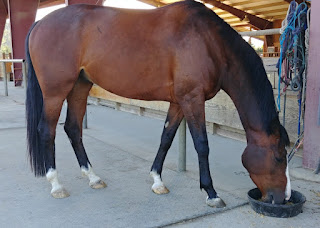November Freedom Farm Newsletter readers! Our apologies, this is last month's article. The blog post you want is here. -MG
In my last post I talked about connecting to the feet in order to foster balanced performance. Taking the example of recent arrival Zeus, a 4-year old with us for training, I emphasized how important the well-balanced, healthy, unshod hoof is to our working horses, as well as training the horse to think with his feet. This time, continuing with Zeus, I want to focus on the relationship of the horse's mouth to his health, well-being, and balanced performance.
As I continued working with Zeus, we advanced to different kinds of schooling. I noticed that he was somewhat tighter on the left side; in a change of direction, the inside left hind leg did not reach under as well as the right hind leg. Also, Zeus’s neck was a little more rigid to the left, and he felt a bit heavier in the bridle on the left side—not a lot, but definitely different than the right.
I knew that various things could cause that left hind to under reach—saddle fit, body soreness, or imbalance in the mouth could all be a factor in these differences. As I had already ruled out body soreness and saddle fit, the next place to look was the balance in his mouth. With a 4 year old, I would not expect to see much of a problem, but my concern about his balance and movement made me want to be sure.
A bit of background:
The horse's teeth are naturally self-maintaining, with a number of factors and processes in play over the life of the horse. It’s too much to go into detail here, but basically, when we look at balance in the mouth, we think in terms of
- Age
- Angle of the molar ‘table’
- Contact of the incisors vs molars
- Grind
- Movement - side to side, forward and back; rotation of the mandible against the maxilla
- Eruption rate - as the teeth emerge from the gums through maturity.
With this in mind, we have made it a priority to understand how the horse's mouth should grind and wear evenly in all stages of the horse’s development. There are distinct angles and contact with the head up and head down, which need to be maintained for the horse to move comfortably.
And of course, we need to understand how the mouth develops from youth to maturity—which teeth are coming into wear at what time. Keeping track of the stages of eruption and the development of the mouth of a young horse is a good idea during early schooling.
In Zeus’s case, he is just getting his last molars in and he still has caps on his corner incisors. As he has been shedding caps normally, has had no trauma to the mouth, one would not necessarily expect imbalances to show up in his mouth or in his work. But with a little study, I could tell something was going on.
Even one tooth out of balance can change the way the whole horse moves. So I knew to check the movement of the jaw to give me an idea of any obvious restrictions to be concerned with. Anyone can learn to do this and it’s a great skill for a proactive horse owner to know. (Watch excerpts of Jerry Schmidt checking a horse's mouth, jaws, etc. on our YouTube channel.)
From watching and listening and a bit of hands-on touch, I could tell that Zeus was limited in his ability to use his jaw to grind across in a circular motion. There was also no forward and backward movement of his lower jaw when his head was up or down. With his jaw’s range of motion so constricted, imbalance was sure to show up in the rest of his body. When balance is restored to Zeus’s mouth we expect to see improvements in his carriage and movement. We’ll keep you posted.
Note: Dental care is not a service we offer at Freedom Farm; however, we have educated ourselves on issues of balance in the mouth, which we hope to include as part of our growing Wise Horsemanship education program. We recommend finding a professional qualified in natural dental balance, who uses hand tools only, and who understands the horse’s mouth; over-adjusting or over-floating often undermines nature's ability to preserve the teeth for the life of the horse. Grinding on the teeth with power tools can interfere with the natural angles of the teeth and reduce the life of the teeth, which over time reduces the life of the horse.
In conclusion, we feel that understanding nature’s model for the horse’s mouth is an important aspect of wise horsemanship, and a definite key to preserving the quality of the life and longevity of the horse.

Great blog post. There's some interesting research into how a horse's mouth influences every muscle in their body including their hind legs.
ReplyDeleteThank you! And yes, it’s amazing. Jerry Schmidt has taught equine body workers how to identify dental issues, based on that knowledge.
Delete